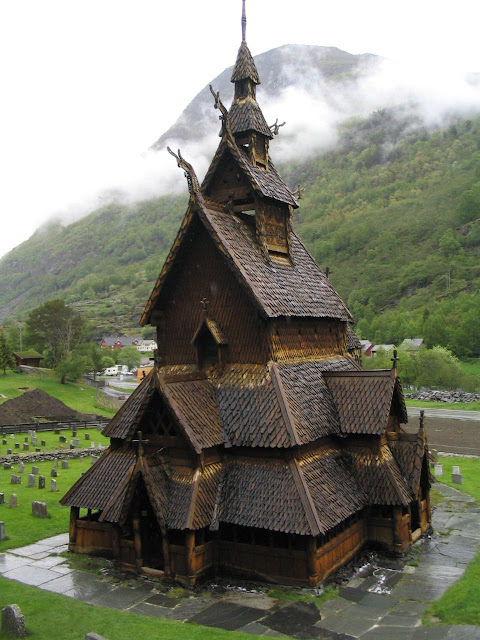Stave Churches
Pastor’s Epistle—July, A.D. 2015 B
Cathedrals of the Forest
Whenever someone asks what I would do if I suddenly
inherited a vast fortune, my first response is always the same: I would build a
stave church.
A stave church is, to me, one of the most beautiful works of
art ever produced by the Church. There used to be some 900 of them throughout
Norway, though only 29 are left there today. The United States has a few of her
own: I know of stave churches in Florida, North Dakota, Wisconsin, and, of
course, at the Hjemkomst Center in Moorhead, MN.
When the Gospel came to the great white north, Viking shipwrights
turned their talents toward houses of worship, thereby erecting masterpieces of
pine and tar. Stave churches are named for the long pine trunks that provide
the central supports for these towering, slender structures, reaching high into
the heavens. Jointed, without any nails whatsoever, stave churches prove
astonishingly flexible, able to withstand snow and wind and Atlantic storms.
Some of them have been in continual use for almost a thousand years.
That they look like pine trees, roof upon roof and spire
upon spire, is no accident. Norse mythology envisioned the universe as a great
tree containing in its branches all the worlds of Creation, its peak reaching
up into Heaven, its roots plunging down to the dead. Ever since St. Boniface,
Germanic peoples have held up the evergreen tree as a symbol for Jesus Christ
triumphing over the oak of Thor. Even the exterior wooden tiles resemble nothing so
much as pinecones.
Inside the worship space, the lush sap smell of Creation,
punctuated by incense, fills the windowless interior. The Northmen were no strangers
to darkness, and here the shadows focused the congregation’s attention on the
burning tapers at the altar, the glittering chalice of Jesus’ Blood, and the brightly
painted images of Christ and Mary with the Apostles and Saints. High in the
rafters were carvings of devils and pagan gods, with even Odin himself
appearing, his head mounted upon the staves like a hunted deer. Outside, dragon
heads and twisting serpents festooned the peaks and doorways of the church,
reminding us of the dark powers of the world which Christ has conquered and subjected
to the light of His authority.
Each stave church has its own legends. Some are said to have
been built by trolls or moved by elves. Some had miraculous crucifixes that
sweated healing oil on Midsummer’s Day. One was lost in the forest for 200
years, only to be rediscovered with a bear hibernating at the altar. The bear’s
pelt still hangs in the sanctuary to this day. In every instance, the
underlying message is this: no matter how frightening the forest outside, the
love of Christ is stronger than all the powers that threaten us. Kvitekrist, “the
White Christ,” has overcome the world.
If all goes well, then about the time that you read this my
wife and I should be in Norway (on a very belated honeymoon), exploring some of
these very stave churches. They are a reminder that the Church is far grander,
and far more beautiful, than we usually admit. Even the Vikings, the terrors of
medieval monasteries, can be overcome by the grace of God in Christ Jesus. May
God bless you in this summer season, and we’ll see you in a couple of weeks.

Your 'god' has triumphed over no-one unless you regard the enforced and violent Christianisation of the Germanic peoples as a 'triumph' of a god of 'love'. Woden and Thunor live on in the blood memory of their people-the Germanic peoples. Indeed on behalf of my Gods I challenge your White Christ to a duel. Is he brave enough to accept? Indeed does he even exist?
ReplyDelete